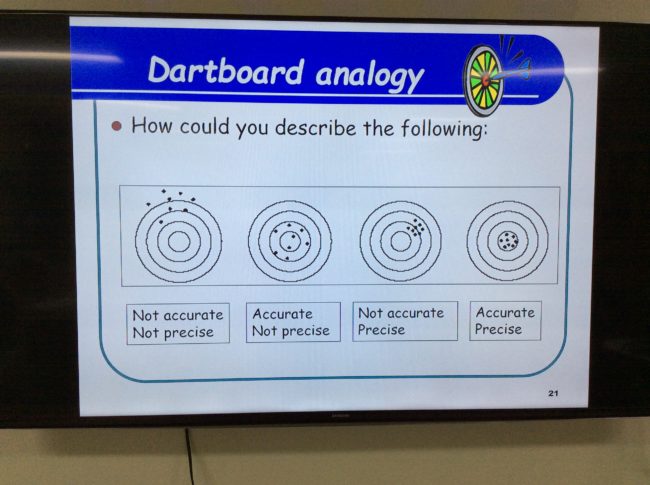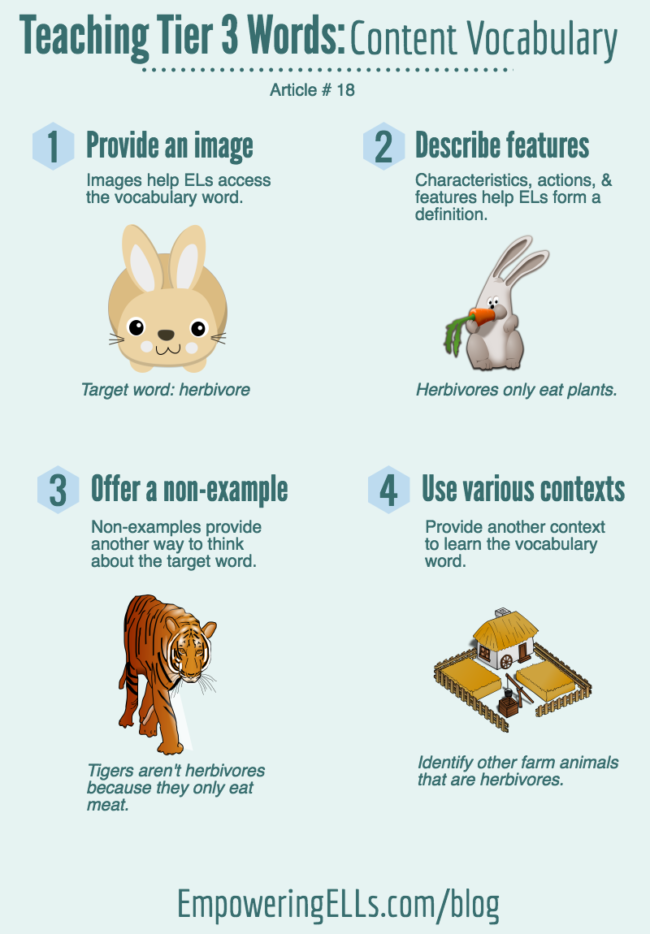The previous three articles presented research on why vocabulary instruction is important to ELs’ academic achievement, how to help ELs learn strategies to quickly understand Tier 1 vocabulary words, and how to teach Tier 2 words , which usually consist of high-utility academic words. The goal of this article is to share a process of teaching content-specific vocabulary to ELs, often referred to as Tier 3 vocabulary words.
Teaching Tier Three Words in Context
Tier Three words are usually those that are mainly content specific and used least frequently. Because they are generally used within a specific discipline, it is best to bring context from that content area to teach them.
I’ll share an anecdote to describe how I teach Tier Three words. I went into Mr. A’s 7th grade science class to help the ELs and non-ELs better learn their science content. Mr. A wanted to teach the concepts of “precise” and “accurate” in order to show them how to evaluate data. I noticed that Anny (an EL) was experiencing difficulty comprehending what he meant. After the usual Google Translate strategy failed to produce any understanding, I had Anny share her data with me. We plotted her data on a “bullseye”. Then we matched her data to Mr. A’s diagram.

After she compared them, our dialogue sounded like this:
Anny: Oh. My data is precise but not accurate.
Mr. Tan: Why is it precise?
Anny: “28” comes up three times in my experiment.
Mr. Tan: Yep. That’s why your data is precise. Can you explain why it is not accurate?
Anny: Well, I think it has to do with how far apart the numbers are.
Mr. Tan: Can you explain it more?
Anny: Yeah. There’s a “21” and there’s also a “35”. The numbers are so far apart.
Below is a video showing this exact lesson. I used Anny’s science data to help her understand “precise” and “accurate” in the actual science context. They’re Tier Three words because they have a specific meaning when scientists employ them to discuss science data.
Using the science context to demonstrate meaning is an example of how to teach vocabulary that is “in context”. Indeed, research suggests explaining words in context is more effective than through non-contextualized instruction (Biemiller & Boote, 2006 as cited by Beck, McKeown, & Kucan, 2008).
Additional Resource on Vocabulary Instruction in General
The most effective book on vocabulary instruct is Creating Robust Vocabulary: Frequently Asked Questions and Extended Examples (Solving Problems in the Teaching of Literacy) by Beck, McKeown, and Kucan (2008). It describes the theory around acquiring vocabulary and provides specific strategies to help students learn vocabulary. By purchasing the book, you also support the blog.
Approaches to Learning Tier 3 Words
I use a combination of four approaches when teaching Tier 3 words. I always try to find an image that is related to the target word because ELs comprehend ideas better when it’s associated with an image. I also try to use the picture to explain the Tier 3 word. For example, if the target word is “photosynthesis”, then I would find a diagram that shows the process of a plant turning water, sunlight, and oxygen into energy.
The third approach is to provide a non-example, a word that does not fit the target word’s definition. This strategy is best used when the EL has already learned the features of the target word. When a non-example is offered, they can compare the differences between the target word and the non-example. The approach that produces the most enduring understanding of a vocabulary word is the fourth one: providing multiple contexts. Provide various situations in which the Tier 3 vocabulary word is incorporated.
Below is an infographic that illustrates these four approaches. Images courtesy of talekids, tzunghaor, Anonymous, and nicubunu.
Quizlet & Tier 3 Vocabulary Practice
In addition to these four strategies, the content teachers and I find the app Quizlet helpful to teaching Tier 3 words because it allows for images to be associated with the selected words. Moreover, the ability to play games and have a portable set of flashcards makes it a highly interactive tool. Here’s an actual Quizlet vocabulary set that I used to help 7th graders learn science vocabulary during an ecosystem unit. Mr. Arno thought the Quizlet was quite effective in helping the ELs learn the content vocabulary that he shared it with his non-ELs as well.
The only downside to Quizlet is that it doesn’t allow students to see the vocabulary word in multiple contexts unless the teacher creates multiple contexts in the Quizlet set.
Closing thought
Though the strategy that I use for Tier I and Tier 2 words differs from that of Tier 3 words, they all share the same principle of learning vocabulary by building a context for ELs through the texts that ELs are reading or the content they’re learning. In my approach, vocabulary is never learned through antiquated, out-of-context vocabulary workbooks. It’s learned through authentic learning experiences in addition to interactions with the content and fellow classmates.
Next Post
I hope that you have enjoyed this collection of articles. They represent the core of my English language instruction to ELs and have been formed through years of research, trial, and error.
The next series will be about the set of articles from WIDA’s Essential Actions Handbook. It’s a collection of articles that shares 15 essential actions -hence the name- that teachers can use to support ELs. Like this Visible Learning series, I will share how I implemented WIDA’s 15 actions. I hope you to see you next week.
Beck, I. L., McKeown, M. G., & Kucan, L. (2002). Bringing words to life: Robust vocabulary instruction. New York: Guilford.


